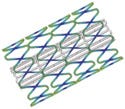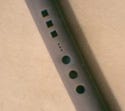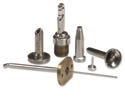Catheters and Stent Fabrication
September 12, 2005
Originally Published MPMN September 2005
Spotlight
Catheters and Stent Fabrication
|
Plasma arc welding system
A welding process for catheters begins when an operator lays a wire on the platform and slides the wire into tooling that holds it in place during welding. The operator presses a foot pedal to pneumatically clamp the tooling onto the wire. Once the tooling is clamped, the operator presses dual palm switches, and the tooling is indexed into the welding position and the weld starts automatically. When the weld is complete the tooling is retracted back to the load-and-unload position and unclamped. The catheter is removed manually. The complete system includes a custom-designed weld fixture with programmable logic controls, a plasma power supply, a low-amp plasma welding torch, a torch accessory kit, a weld programmer, gas regulators, ground cables, interface cables, and hoses. Process Welding Systems Inc., LaVergne, TN
www.pwsweld.com
Motion system
|
A fully integrated motion system used for stent manufacturing couples automated material-handling functionality with high-performance direct-drive linear and rotary motion capability. The integral linear-rotary design increases throughput by two to five times compared with traditional screw-based or other manufacturing approaches, while still maintaining submicron tolerances on tight-part geometries. The increased throughput of the VascuLathe means that fewer machines are required to produce an equivalent number of stents in the same time period. Aerotech Inc., Pittsburgh, PA
www.aerotech.com
Stent manufacturing
|
A company manufactures stents and other tubular devices from early development through full-scale production. Development services include complete integrated prototyping and design consulting to speed time to market for all types of medical device firms. Capabilities consist of laser machining, heat-shaping of nitinol, materials testing and characterization, and electropolishing and surface finishing. The company specializes in processing stainless steel, nitinol, cobalt-based superalloys, titanium, and tantalum. Nitinol heat-forming can be tailored to suit a variety of device-performance requirements. Burpee Materials Technology LLC, Eatontown, NJ
www.burpeetech.com
Tip forming and bonding
|
A process equipment supplier specializes in tip forming and bonding of medical catheters. The company designs and builds customized catheter-tipping and -bonding equipment and tooling worldwide. Its precision tipping systems are multiple-project machines that can tip or weld almost all thermoplastic materials. Programmable controls, a stepping motor drive for precision feed, and quick-change tools are some of the features. Cath-Tip Inc., Sandy, UT
www.cathtip.com
Catheter-processing equipment
|
Tube-processing systems are used to apply high-pressure heat during bonding applications for a variety of catheter systems within the medical device industry. Semiautomated process capabilities include multilumen welds, braided-to-nonbraided butt welds, braided-to-braided butt welds, balloon-to-shaft bonding, and balloon-to–distal or –proximal tip bonding. The company also offers the four-station vertical shrinker, thermal box, and distal or proximal tip bonder. Integral to the company’s bonding equipment is a Microswirl 360° thermal nozzle that provides uniform heating characteristics and minimizes the incidence of hot or cold spots during the shrinking process,
as compared with flat or “C” nozzle technologies. Machine Solutions Inc., Flagstaff, AZ
www.machinesolutions.com
Stent and catheter production
Prototyping, development, and production capabilities are offered for stent and catheter applications. Both metal and polymer tubes, including stents, can be processed with complex feature sizes as small as 2 µm. Smart catheters with conductive circuitry are being developed for sensor and marker band applications. The company is ISO 9001:2000 certified and can process prototypes within 48 hours. Potomac Photonics, Lanham, MD
www.potomac-laser.com
|
|
|
High-yield catheter production
|
Two systems are available for high-yield catheter production. The PIRF II system forms complex, small-profile catheters by concentrating heat in bands less than 1 mm. The precise heat placement produces high-quality tips and strong welds, which is critical when welding parts such as braided-to-nonbraided tubing and materials with durometers. The PIRF III system can tip multiple parts and can form large catheters. Both systems feature the company’s proprietary temperature control, which controls temperature to 1°C in each cycle. Sebra, Tucson, AZ
www.sebra.com
Catheter design and production
|
A company’s engineers specialize in tipping, drilling, neckdowns, and custom injection molding of catheters. Intricate designs, precision engineering, fabricating, and assembly of the most critical medical components are some of the company’s capabilities. Single-prototype to large-production-volume quantities can be accommodated. MedConnection LLC, Phillipsburg, NJ
www.medconnection.net
Catheter-tipping dies
|
Catheter-manufacturing productivity and end product quality can be achieved using a company’s catheter-tipping dies. NiColoy tipping dies ensure fast heating and cooling cycles, according to the company. The electroformed dies incorporate a uniform wall thickness as thin as 0.010 in. The surface finish inside the dies is 8 µm or better. Other features include integrated mandrel pins, complex tip geometries, good release properties, and the flexibility to work in any tipping machine. A two-week turnaround time is standard. NiCoForm, Rochester, NY
www.nicoform.com
Copyright ©2005 Medical Product Manufacturing News
You May Also Like













